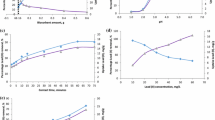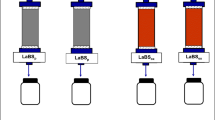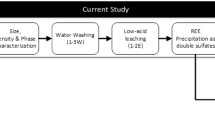Abstract
We present a feasibility study of different adsorbent materials, namely residual fish scales biosorbent (FS), mineral dolomite (DL) and commercial resin (CR) in the heavy metals removal in multicomponent solution based on the properties of a real effluent from automotive battery recycling industry. Considering the effluent complex characteristics, the materials were assessed aiming to provide not only the heavy metals removal, but also the effluent neutralization and lower sludge generation. For this, all the studied materials were physicochemically and morphologically characterized with the aim of understanding the mechanisms involved in the process. Further, the elemental compositions of the solid and liquid phases generated from each treatment process were assessed by X-ray fluorescence spectrometry. The effluent presented highly acidic characteristics and heavy metals above the legislated limits for discharge (Fe, Zn and Pb). Each adsorbent material followed different mechanisms which led to dissimilar removal and neutralization capacities. The CR showed remarkable heavy metals removal capacity governed by an ion exchange mechanism; conversely, it did not show a neutralization effect. In contrast, FS and DL presented lower removal capacities by complex simultaneous phenomena (ion exchange, precipitation and/or complexation), but a great neutralization potential related to leaching of alkaline constituents. When sludge generation is considered as a key factor, mitigation and enhancement of treated effluent quality could alternatively be addressed by employing the materials in hybrid processes. Hence, the associated use of such materials could be viable yet very challenging for both neutralization and removal of heavy metals from the battery effluent.






Similar content being viewed by others
References
Bahadir T, Bakan G, Altas L, Buyukgungor H (2007) The investigation of lead removal by biosorption: an application at storage battery industry wastewaters. Enzyme Microb Technol 41:98–102
Needleman H (2004) Lead poisoning. Annu Rev Med 55:209–222
Gottesfeld P, Cherry CR (2011) Lead emissions from solar photovoltaic energy systems in China and India. Energy Policy 39:4939–4946
Feng Y, Wang Y, Wang Y et al (2017) Simple fabrication of easy handling millimeter-sized porous attapulgite/polymer beads for heavy metal removal. J Colloid Interface Sci 502:52–58
Sun Z, Cao H, Zhang X et al (2017) Spent lead-acid battery recycling in China—a review and sustainable analyses on mass flow of lead. Waste Manag 64:190–201
Quiterio SL, Moreira FR, Da Silva CRS et al (2006) Avaliação da poluição ambiental causada por particulado de chumbo emitido por uma reformadora de baterias na cidade do Rio de Janeiro, Brasil (in Portuguese). Cad Saude Publica 22:1817–1823
Milanez B, Bührs T (2009) Capacidade Ambiental e Emulação de Políticas Públicas: O Caso da Responsabilidade Pós-Consumo Para Resíduos de Pilhas e Baterias no Brasil (in Portuguese). Planej e Políticas Públicas 33:257–289
Abdolali A, Ngo HH, Guo W et al (2017) Application of a breakthrough biosorbent for removing heavy metals from synthetic and real wastewaters in a lab-scale continuous fixed-bed column. Bioresour Technol 229:78–87
Maruthamuthu S, Dhanibabu T, Veluchamy A et al (2011) Elecrokinetic separation of sulphate and lead from sludge of spent lead acid battery. J Hazard Mater 193:188–193
Ambrose H, Gershenson D, Gershenson A, Kammen D (2014) Driving rural energy access: a second-life application for electric-vehicle batteries. Environ Res Lett 9:94004
Pehlivan E, Özkan AM, Dinç S, Parlayici Ş (2009) Adsorption of Cu2+ and Pb2+ ion on dolomite powder. J Hazard Mater 167:1044–1049
Reichert J, Binner JGP (1996) An evaluation of hydroxyapatite-based filters for removal of heavy metal ions from aqueous solutions. J Mater Sci 31:1231–1241. https://doi.org/10.1007/BF00353102
Padilla-Ortega E, Leyva-Ramos R, Flores-Cano JV (2013) Binary adsorption of heavy metals from aqueous solution onto natural clays. Chem Eng J 225:536–546
Salameh Y, Albadarin AB, Allen S et al (2015) Arsenic(III, V) adsorption onto charred dolomite: charring optimization and batch studies. Chem Eng J 259:663–671
Wu M, Zhang J, Peng Y et al (2017) An investigation into mechanism of cation adsorption by reconstruction of calcined layered double hydroxide. Microporous Mesoporous Mater 242:182–189
Ghosh SN, Vishwanathan VN, Chatterjee AK (1976) Estimation of dolomite mineral in limestone by infra-red spectroscopy. J Mater Sci 11:1167–1170. https://doi.org/10.1007/BF00553128
Liu Z, Shen Q, Zhang Q et al (2014) The removal of lead ions of the aqueous solution by calcite with cotton morphology. J Mater Sci 49:5334–5344. https://doi.org/10.1007/s10853-014-8236-x
Farnane M, Tounsadi H, Elmoubarki R et al (2017) Alkaline treated carob shells as sustainable biosorbent for clean recovery of heavy metals: kinetics, equilibrium, ions interference and process optimisation. Ecol Eng 101:9–20
Bhatt RR, Shah BA (2015) Sorption studies of heavy metal ions by salicylic acid-formaldehyde-catechol terpolymeric resin: isotherm, kinetic and thermodynamics. Arab J Chem 8:414–426
Bento HBS, de Castro HF, de Oliveira PC, Freitas L (2017) Magnetized poly(STY-co-DVB) as a matrix for immobilizing microbial lipase to be used in biotransformation. J Magn Magn Mater 426:95–101
Liu B, Wang D, Xu Y, Huang G (2011) Adsorption properties of Cd(II)-imprinted chitosan resin. J Mater Sci 46:1535–1541. https://doi.org/10.1007/s10853-010-4958-6
Gadd GM (2009) Biosorption: critical review of scientific rationale, environmental importance and significance for pollution treatment. J Chem Technol Biotechnol 84:13–28
Fomina M, Gadd GM (2014) Biosorption: current perspectives on concept, definition and application. Bioresour Technol 160:3–14
Espinoza-Quiñones FR, Módenes AN, de Pauli AR, Palácio SM (2015) Analysis of trace elements in groundwater using ICP-OES and TXRF techniques and its compliance with Brazilian protection standards. Water Air Soil Pollut 226:32
Park J, Regalbuto JR (1995) A simple, accurate determination of oxide PZC and the strong buffering effect of oxide surfaces at incipient wetness. J Colloid Interface Sci 175:239–252
Brazil (2005) Norm 357/2005 (in Portuguese) published on the Union Official Newspaper of Brazil (18 March 2005), No. 53, pp 58–63. Brazilian Council of Environmental Quality Regulation—CONAMA
Ribeiro C, Scheufele FB, Espinoza-Quiñones FR et al (2015) Characterization of Oreochromis niloticus fish scales and assessment of their potential on the adsorption of reactive blue 5G dye. Colloids Surf A Physicochem Eng Asp 482:693–701
Albadarin AB, Mangwandi C, Al-Muhtaseb AH et al (2012) Kinetic and thermodynamics of chromium ions adsorption onto low-cost dolomite adsorbent. Chem Eng J 179:193–202
Al Lafi AG, Al Abdullah J (2015) Cesium and cobalt adsorption on synthetic nano manganese oxide: a two dimensional infra-red correlation spectroscopic investigation. J Mol Struct 1093:13–23
Colthup NB (1950) Spectra-structure correlations in the infra-red region. J Opt Soc Am 40:397
Derrick MR, Stulik D, Landry JM (1999) Infrared spectroscopy in conservation science. The Getty Conservation Institute, Los Angeles
Miller FA, Wilkins CH (1952) Infrared spectra and characteristic frequencies of inorganic ions. Anal Chem 24:1253–1294
Movasaghi Z, Rehman S, ur Rehman I (2008) Fourier transform infrared (FTIR) spectroscopy of biological tissues. Appl Spectrosc Rev 43:134–179
Nyquist RA, Kagel RO (1971) Infrared spectra of inorganic compounds. Handbook of infrared and raman spectra of inorganic compounds and organic salts, 1st edn. Academic Press, Michigan, pp 1–18
Smidt E, Meissl K (2007) The applicability of Fourier transform infrared (FT-IR) spectroscopy in waste management. Waste Manag 27:268–276
Marrakchi F, Ahmed MJ, Khanday WA et al (2017) Mesoporous carbonaceous material from fish scales as low-cost adsorbent for reactive orange 16 adsorption. J Taiwan Inst Chem Eng 71:47–54
Skoog DA, Holler FJ, Crouch SR, Douglas A, Skoog F, James Holler SRC (2007) Principles of instrumental analysis, 6th edn. Thomson Brooks/Cole, Belmont
Minamisawa M, Minamisawa H, Yoshida S, Takai N (2004) Adsorption behavior of heavy metals on biomaterials. J Agric Food Chem 52:5606–5611
Saber-Samandari S, Saber-Samandari S, Nezafati N, Yahya K (2014) Efficient removal of lead (II) ions and methylene blue from aqueous solution using chitosan/Fe-hydroxyapatite nanocomposite beads. J Environ Manag 146:481–490
He X, Che R, Wang Y et al (2015) Core-nanoshell magnetic composite material for adsorption of Pb(II) in wastewater. J Environ Chem Eng 3:1720–1724
Nadeem R, Ansari TM, Khalid AM (2008) Fourier transform infrared spectroscopic characterization and optimization of Pb(II) biosorption by fish (Labeo rohita) scales. J Hazard Mater 156:64–73
Michalak I, Chojnacka K, Witek-Krowiak A (2013) State of the art for the biosorption process—a review. Appl Biochem Biotechnol 170:1389–1416
Liu R, Liu H, Qiang Z et al (2009) Effects of calcium ions on surface characteristics and adsorptive properties of hydrous manganese dioxide. J Colloid Interface Sci 331:275–280
Uzunoğlu D, Özer A (2016) Adsorption of hazardous heavy metal copper(II) from aqueous effluents onto waste material fish (Dicentrarchus labrax) scales: optimization, equilibrium, kinetics, thermodynamic, and characterization studies. Desalin Water Treat 57:22794–22798
Correia LM, de Sousa Campelo N, Novaes DS et al (2015) Characterization and application of dolomite as catalytic precursor for canola and sunflower oils for biodiesel production. Chem Eng J 269:35–43
Mangwandi C, Albadarin AB, Glocheux Y, Walker GM (2014) Removal of ortho-phosphate from aqueous solution by adsorption onto dolomite. J Environ Chem Eng 2:1123–1130
Yoshida M, Koilraj P, Qiu X et al (2015) Sorption of arsenate on MgAl and MgFe layered double hydroxides derived from calcined dolomite. J Environ Chem Eng 3:1614–1621
Albadarin AB, Mo J, Glocheux Y et al (2014) Preliminary investigation of mixed adsorbents for the removal of copper and methylene blue from aqueous solutions. Chem Eng J 255:525–534
Ivanets AI, Kitikova NV, Shashkova IL et al (2016) Using of phosphatized dolomite for treatment of real mine water from metal ions. J Water Process Eng 9:246–253
Al-Degs YS, El-Barghouthi MI, El-Sheikh AH, Walker GM (2008) Effect of solution pH, ionic strength, and temperature on adsorption behavior of reactive dyes on activated carbon. Dye Pigment 77:16–23
Yang S, Guo Z, Sheng G, Wang X (2012) Application of a novel plasma-induced CD/MWCNT/iron oxide composite in zinc decontamination. Carbohydr Polym 90:1100–1105
Liang Z, Shi W, Zhao Z et al (2017) The retained templates as “helpers” for the spherical meso-silica in adsorption of heavy metals and impacts of solution chemistry. J Colloid Interface Sci 496:382–390
Mohammadi M, Ghaemi A, Torab-Mostaedi M et al (2015) Adsorption of cadmium (II) and nickel (II) on dolomite powder. Desalin Water Treat 53:149–157
Ciopec M, Negrea A, Lupa L et al (2014) Studies regarding As(V) adsorption from underground water by Fe-XAD8-DEHPA impregnated resin. Equilibrium sorption and fixed-bed column tests. Molecules 19:16082–16101
Singh AN, Singh S, Dubey VK (2013) Immobilization of procerain B, a cysteine endopeptidase, on amberlite MB-150 beads. PLoS ONE 8:e66000
Scheufele FB, Módenes AN, Borba CE et al (2016) Monolayer–multilayer adsorption phenomenological model: kinetics, equilibrium and thermodynamics. Chem Eng J 284:1328–1341
Zhou K, Yang Z, Liu Y, Kong X (2015) Kinetics and equilibrium studies on biosorption of Pb(II) from aqueous solution by a novel biosorbent: Cyclosorus interruptus. J Environ Chem Eng 3:2219–2228
Parga JR, Valenzuela JL, Munive GT et al (2014) Thermodynamic study for arsenic removal from freshwater by using electrocoagulation process. Adv Chem Eng Sci 4:548–556
Oliva J, De Pablo J, Cortina J-L et al (2010) The use of apatite II™ to remove divalent metal ions zinc(II), lead(II), manganese(II) and iron(II) from water in passive treatment systems: column experiments. J Hazard Mater 184:364–374
Atkins PW, Jones L, Laverman L (2016) Chemical principles: the quest for insight, 7th edn. W.H. Freeman, New York
Neves JS, De Souza FG, Suarez PAZ et al (2011) In situ production of polystyrene magnetic nanocomposites through a batch suspension polymerization process. Macromol Mater Eng 296:1107–1118
Masoumi A, Ghaemy M (2014) Adsorption of heavy metal ions and azo dyes by crosslinked nanochelating resins based on poly(methylmethacrylate-co-maleic anhydride). Express Polym Lett 8:187–196
Correll DL (1998) The role of phosphorus in the eutrophication of receiving waters: a review. J Environ Qual 27:261
Monte Blanco SPD, Scheufele FB, Módenes AN et al (2017) Kinetic, equilibrium and thermodynamic phenomenological modeling of reactive dye adsorption onto polymeric adsorbent. Chem Eng J 307:466–475
Villanueva-Espinosa JF, Hernandez-Esparza M, Ruiz-Trevino FA (2001) Adsorptive properties of fish scales of Oreochromis Niloticus (Mojarra Tilapia) for metallic ion removal from waste water. Ind Eng Chem Res 40:3563–3569
Ikoma T, Kobayashi H, Tanaka J et al (2003) Microstructure, mechanical, and biomimetic properties of fish scales from Pagrus major. J Struct Biol 142:327–333
Acknowledgements
The authors are very grateful to National Council for Scientific and Technological Development (CNPq) for the financial support of this study (Grant Number 480107/2013-0).
Author information
Authors and Affiliations
Corresponding author
Electronic supplementary material
Below is the link to the electronic supplementary material.
Rights and permissions
About this article
Cite this article
Ribeiro, C., Scheufele, F.B., Espinoza-Quiñones, F.R. et al. A comprehensive evaluation of heavy metals removal from battery industry wastewaters by applying bio-residue, mineral and commercial adsorbent materials. J Mater Sci 53, 7976–7995 (2018). https://doi.org/10.1007/s10853-018-2150-6
Received:
Accepted:
Published:
Issue Date:
DOI: https://doi.org/10.1007/s10853-018-2150-6




